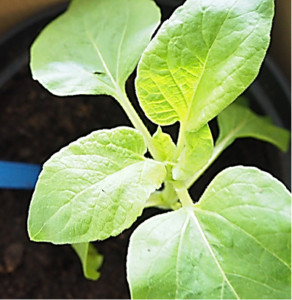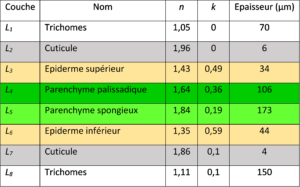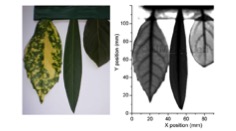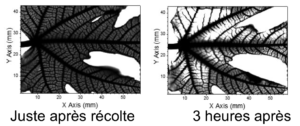THz and Agronomy
The multilayer structure of sunflower leaves revealed by terahertz waves
To explore the multilayer structure of leaves, a new non-contact, non-invasive analysis method based on pulsed terahertz spectroscopy has been developed. For the first time, this innovative technique enables in-depth observation of the multilayer structure of the leaf blade (sunflower in the present study). Combined with calculation codes, it enables us to obtain, for a given genotype, the number of layers making up the leaf blade, as well as their respective thicknesses, refractive indices and absorption coefficients, the refractive index and absorption coefficient being associated with the composition of the layer. This technique also makes it possible to monitor the progression of these parameters over time, particularly when plants are subjected to controlled environmental variables.
 |
 |
|
| Sunflower leaves probed by impulse terahertz spectroscopy. | Parameters obtained for the 8-layer structure of a sunflower leaf: thicknesses, real (n) and complex (k) indices |
Y. Abautret, D. Coquillat, M. Zerrad, et al. Terahertz probing of sunflower leaf multilayer organization. OPTICS EXPRESS 28, 35018-35037 (2020).
Monitoring plant response to water stress using Terahertz imaging and spectroscopy
Environmental stresses (drought, salinity and possibly low temperatures) affect plant growth and yield, and the south of France is one of the areas in the world where there is a risk of accentuated drought, with harmful consequences for agriculture. The response of plants to stress is both cellular and molecular; for example, they undergo significant water loss at the cellular level. Current methods for studying these responses have a number of drawbacks, in particular because they are destructive or alter plant organs. The THz frequency domain can be used for non-contact monitoring of stress at both cellular and morphological levels, and promises interesting results at the molecular level.
 |
 |
|
| Visible (left) and 300 GHz (right) images | Fig leaf transmission at 0.65 THz |
To improve plant tolerance to environmental stresses, transgenic plants have been produced around the world. However, the potential risks associated with transgenic plants are still uncertain. To detect the existence and quantities of transgenic plants, reliable, sensitive and possibly non-destructive methods are badly needed. Very recent studies of THz spectroscopy, combined with chemometric analysis techniques (most published in 2016) have shown the discrimination of transgenic plants using these new techniques (seeds, proteins, etc.). In addition, these new techniques should provide information on differences in chemical composition between transgenic and conventional plants.